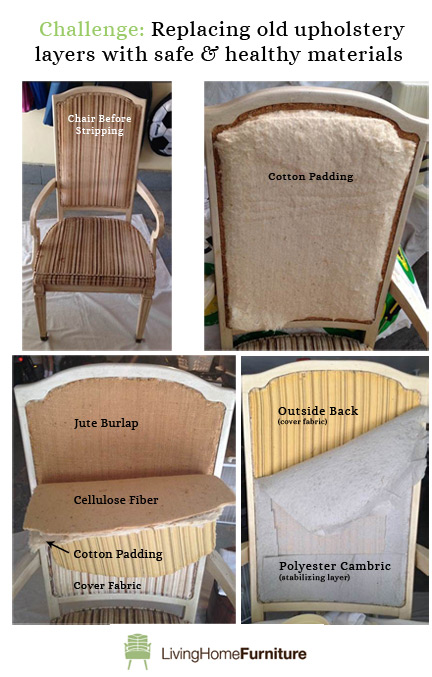The Challenge: Replacing old upholstery layers with safe & healthy materials.
Here’s a familiar story from an eco- and health-conscious person who recently sent me these chair photos:
My daughter and I had rescued these 2 Davis Cabinet Company chairs from our Habitat ReStore and wanted to re-upholster to bring them back to good use. The backs were upholstered too and as we were carefully taking apart all the old upholstery and saving for patterns we realized that we did not have the expertise, tools and time to transform them ourselves.
We took the chairs, our fabric, trim and expensive latex foam to an upholsterer, who said we should have gotten a thicker foam and needed some batting to add for padding so the seat would not be flat but rounded and softer. The chair back also needed some felt padding.
My issue is this and you indicated as much on your site. The upholsterer would use his own materials but they would be toxic and I do not want that. So now, I need to find some wool felt padding and some cotton batting and as you said some cotton ticking. I am new to this task and here in Nashville, TN, there are only a few places that carry anything but some upholstery fabric. They do not have in stock the other pieces and parts you would need to complete your project.
Please let me know if you can tell what the different layers are. Thanks for all your advice and help.
Q: What is toxic in this mix and what are the safe and earth-friendly alternatives?
A: Here’s a close-up look, layer by layer, with suggested alternative materials for each:
Upholstery Cover Fabric: There are many eco-friendly fabrics available today that are suitable for upholstery, which you can find online if you don’t have a fancy fabric store nearby. You can start with Birch Fabrics, Oliviera Textiles, Two Sisters Ecotextiles or Spoonflower. Or use Google image search, and play around with descriptive words: for example ‘organic nature-inspired bird fabric’ will yield a whole slew of ideas – not all the results will be fabrics for sale, but I almost always find something useful with this method.
Cotton Padding: Standard upholsterers’ cotton padding is generally a mix of cotton fibers with what is called ‘cotton linters’ – the short fuzz from the seed heads produced when the seeds are milled into oil. I haven’t studied it in depth, but from my work with this padding in my upholstery studio, I’m guessing it is not directly treated with flame retardants or other chemicals. However, you can pretty much count on the presence of a certain amount of the pesticides used in growing the cotton. You can learn more about the science behind cotton production here.
Cellulose Fiber: Cellulose is a primary structural component of the cell walls of plants. Cellulose fiber for upholstery is mainly obtained from wood pulp & cotton (similar to rayon). Because I have only seen cellulose fiber like this in older furniture in my upholstery work, I don’t believe it is in use today. I suggest you replace this layer by simply adding some thickness to your cotton batting.
Jute Burlap: As a rule, jute (along with hemp & linen) does not require the use of pesticides to grow, so is a sustainable and safe fiber for your upholstery project.
Polyester Cambric can be replaced with jute burlap (available from your upholsterer or your local Joann fabrics) or a hemp canvas (try Hemp Traders).
Polyester Batting is one commonly used upholstery layer that was not used on this chair but deserves mention. Much like the quilt batting most of us are familiar with, it is placed between the cover fabric and the outer layer of padding to soften the edges and add a hint of dimension. Rather than go into a long discussion of polyester’s impact on ecosystems, factory workers and end-users, I will refer you to this informative article by Oecotextiles. In short, polyester in any form is a petroleum-based plastic. If you’re inclined to take the natural alternative, I recommend wool batting. You’ll need a ticking fabric between it and your cover fabric to prevent the migration and ‘pilling’ of wool fibers on the surface of the fabric. See below for information on how to order wool & ticking from Living Home Furniture beginning mid-June, 2015.
Polyurethane foam used in upholstery between 1975 and 2013 is very likely to contain some very nasty flame retardants (FRs), and I recommend to anyone reupholstering furniture from this time period to have the foam replaced with an OekoTex certified FR-free alternative. Even if you find a urethane foam that is FR-free, there are significant issues to consider about the polyurethane foam manufacturing process. Oecotextiles offers a detailed look at sofa foam in this post.

Check out the vendor resource page to purchase natural and organic latex foam, wool batting and organic cotton ticking. To learn more, be sure to sign up for the mailing list.
